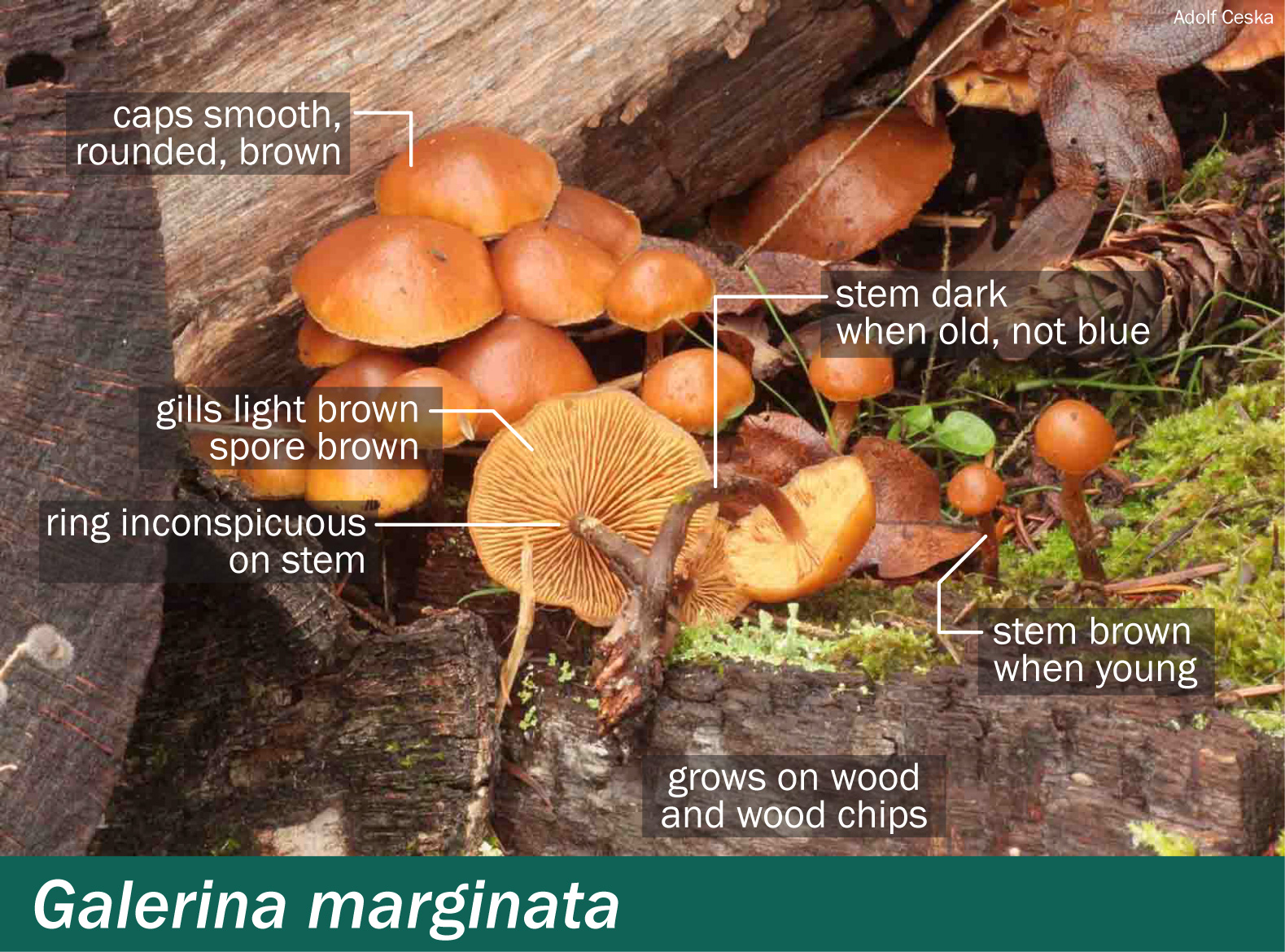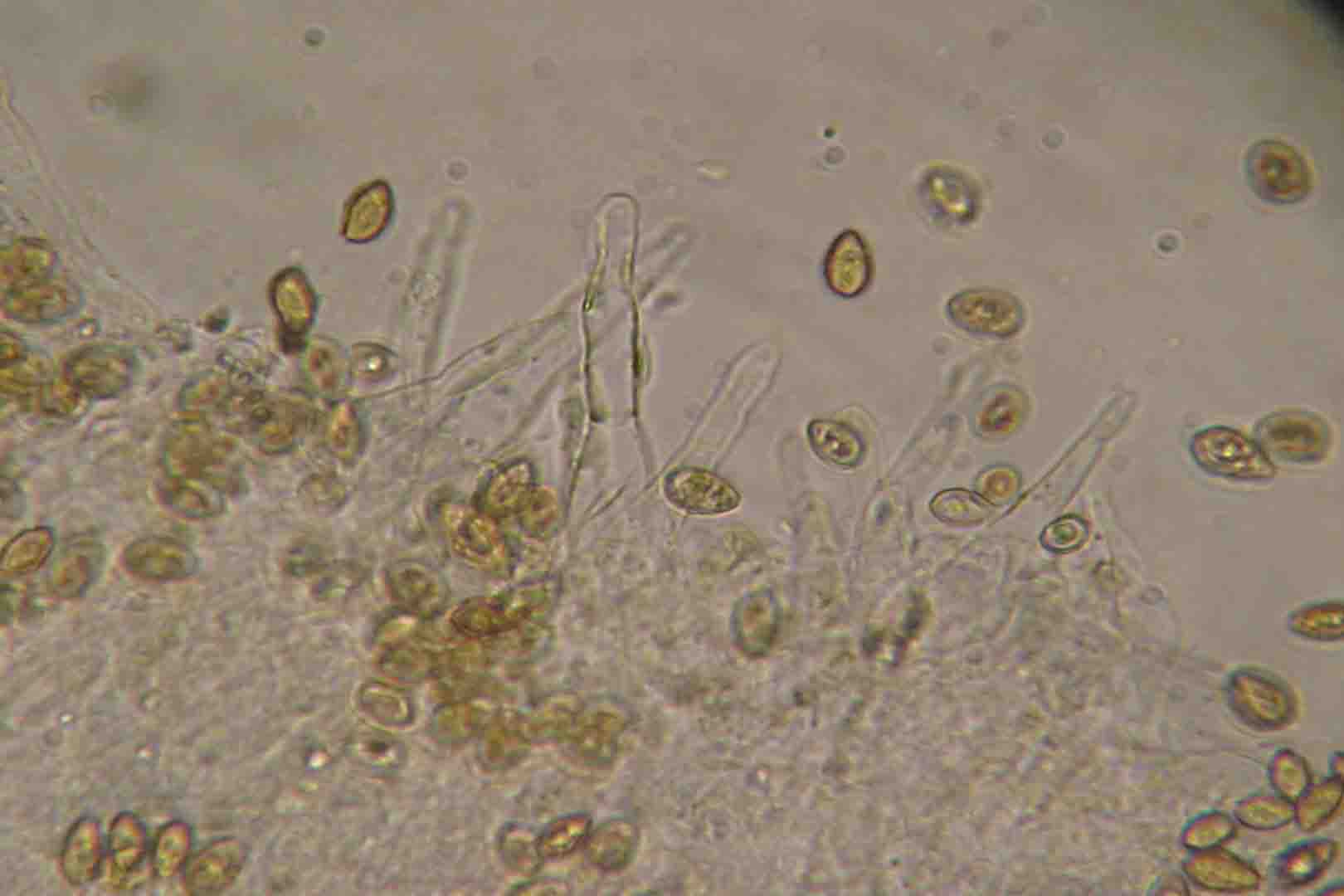Galerina marginata — Deadly galerina
Odour: Indistinct or like old flour
Cap: 1.5 to 5 (8) cm in diameter, hemispherical when young, may have an umbo in the middle. With age, caps expand, becoming convex to almost flat. Ochre to orange-brown or yellowish brown, with a lighter rim. The surface is smooth and dry or when moist, slightly viscid or greasy to touch. Flesh is thin.
Gills: Crowded, attached, sometimes slightly decurrent, pale brown to yellowish or yellow-brown.
Stems: 2-8 cm long x 0.3-1 cm wide, beige at top, darker to almost black towards the base.
Ring or veil: Small membranous or fibrillose ring located nearer the top than the base of the stem. Check young mushrooms! In older specimens, the ring is often missing, or if visible, it may consist of only a few fibrils on the stem that are hard to see.
Cup: None.
Spores: 8-11 (13) x 5-6.5 (7) µm, almond-shaped, roughened.
Other microscopic features: The edges of the gills have cystidia, enlarged cells with elongate, finger-like extensions hanging down (see image above).
Habitat: On rotting wood of conifers or broadleaved trees, on wood chips in urban areas. Sometimes, wood is buried and the fungi appear to be growing from the ground or amid moss.
Geographical range:1 Northern Hemisphere, common in Pacific northwest and BC.
Galerina species could be confused with Psilocybe species. Again, spore colour helps; Psilocybe species have dark brownish/purplish spores rather than reddish-brown spores.
The numerous different Galerina species are very difficult to distinguish from deadly galerinas, and toxin content of different species has yet to be investigated.
Toxins8,9: Amatoxins, heat-stable cyclic peptides that are not destroyed by cooking. Amatoxins stop protein synthesis by inhibiting an essential enzyme, RNA polymerase II.
Symptoms10,11: Time of onset, 6-10 hours after eating, nausea, vomiting, diarrhoea. About 36 hours after ingestion, abnormal, high levels of liver enzymes aspartate aminotransferase and alanine aminotransferase may be detectable in blood chemistry. Liver failure may follow at about 72 hours after ingestion.
Treatment: Contact your regional Poison Control Centre if you or someone you know is ill after eating any small brown mushrooms. Poison centres provide free, expert medical advice 24 hours a day, seven days a week. If possible, save the mushrooms or some of the leftover food containing the mushrooms to help confirm identification.
Poison Control:
British Columbia: 604-682-5050 or 1-800-567-8911.
United States (WA, OR, ID): 1-800-222-1222.
Cases:
- Reflecting the sporadic and serious nature of Galerina poisonings, 10 North American cases were compiled from 1985-20066. Of these, liver damage was reported in six cases, kidney failure in one case. Keeping in mind that only ~10% of mushroom poisonings are reported, actual exposures to Galerina toxins may have been considerably more frequent.
- A 32-year-old woman in Sweden collected, fried and ate what she thought were honey mushrooms10. 10 hours later vomiting and diarrhea began and 7 hours later, she went to the hospital. Blood tests showed high levels of amanitins and blood enzyme levels indicating liver damage. She was treated with fluids, repeated doses of charcoal presumably to prevent reabsorption of the amanitin, thioctic acid and penicillin G. She recovered and was discharged from the hospital in 9 days10.
- In Japan a six-year-old boy and his family ate a meal of Galerina mushrooms11. He experienced the typical symptoms of vomiting and diarrhea about 6-10 hours later. His family experienced similar, but much milder symptoms. The boy was admitted to hospital with signs of liver damage 36 hours after ingesting the mushrooms, which became progressively worse, leading to complete liver failure 72 hours after ingestion. The child recovered after treatment with activated charcoal, a cathartic, hemodiafiltration and plasma exchanges11.



